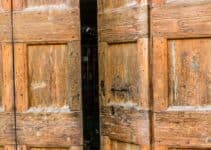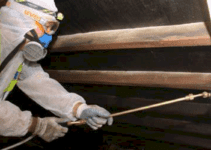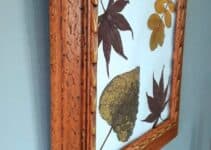While knowing the different types of wood beetle isn’t completely necessary for treatment, it can help you work out what type is infesting your home. Types of wood beetle also have different infestation signs, allowing you to tell whether the infestation is still active or not.
In this article, we’ll cover the different types of wood beetle, along with the typical signs they leave around your home.
Is Wood Boring Beetle the Same as Woodworm?
A wood boring beetle is the same as woodworm, as the insects are actually beetles, not worms. If we want to be as technical as possible, woodworm refers to the larvae of the beetles.
Unsurprisingly, these look far more like worms than the adults.
The larvae cause more damage inside the wood, but the telltale holes in timbers come from adults boring their way out.
Either way, the terms woodworm, wood beetle and wood boring beetle are used interchangeably. This is absolutely fine, as the distinctions aren’t important when determining if you have an infestation.
What Are the Different Types of Wood Beetle?
In the UK, we have 5 main types of wood boring beetle that are found in homes. There are another 6 types of wood boring insects found in the country, but these either aren’t beetles or live in the wild.
As such, it’s not super important to mention them here, although we’ll touch upon a few of them.
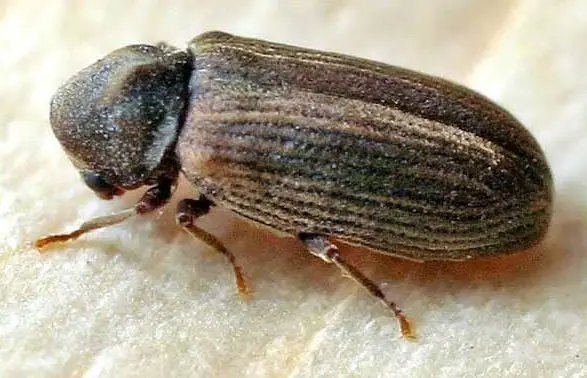
Common Wood Beetle
Also called the common furniture beetle, it’ll probably come as no surprise that this is the most common type of woodworm in the country.
It’s found in homes and in the wild, specifically in the sapwood of timber. It’s happy with softwoods like pine and hardwoods like ash, beech and elm.
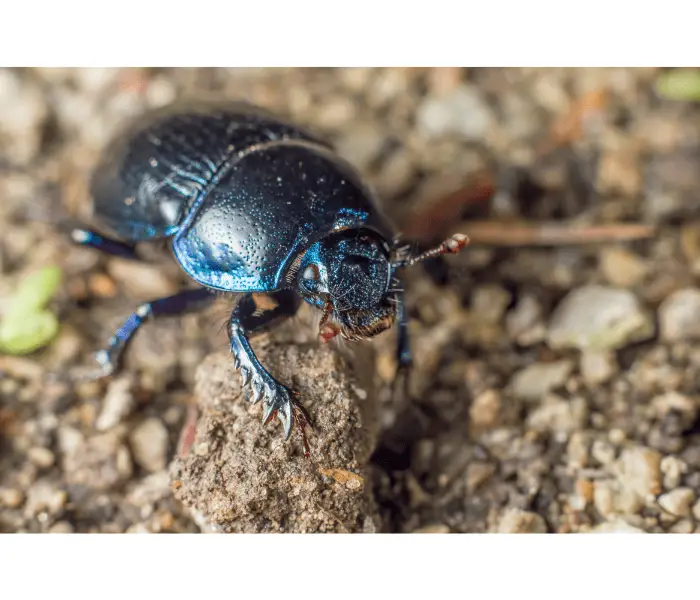
Adult beetles are light green/brown and around 5mm in length. They leave 2mm round holes in timber when they emerge.
Larvae can live for 3-5 years in wood before turning into adults. Common wood beetles typically bore along the wood grain rather than against it.
They prefer untreated wood with a minimum moisture content of 12%. However, it’s most common to find them in damp areas, such as attics or floors where the wood is easier to bore.
The beetle’s frass (wood boring waste) comes out as sandy brown pellets.
Death Watch Beetle
The death watch beetle is the next most common type of wood boring insect in the UK. Its name comes from the tapping sound it makes during mating season.
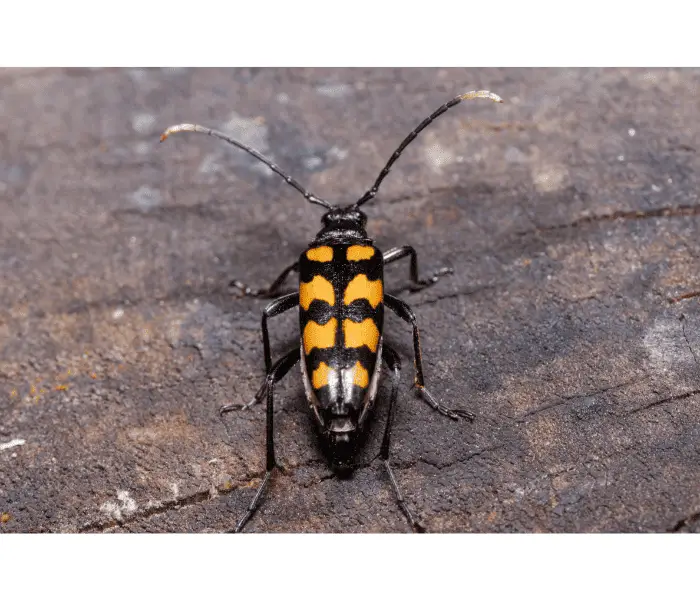
It sounds a bit like a ticking clock, which people associated with the ticking clock of death.
The adults are brown and slightly furry and look a bit like bees. They can grow up to 7mm long, while the larvae are around 1cm.
Larvae can live for up to 7 years in timber before turning into adults, which emerge through 3mm holes with neat edges.
It prefers moist and decaying hardwood, such as oak, elm, and chestnut. As such, it’s most commonly found in older buildings that used these materials, particularly in damp and untreated areas like attics. Its frass is bun shaped.
House Longhorn Beetle
Also known as the house borer, the house longhorn beetle is a less common type of woodworm in the UK. However, it’s more difficult to get rid of and can cause extensive damage to a building’s structure.
This is because it prefers softwood, such as pine and fir, which are used extensively in modern buildings for framework.
Adults can be up to 2.5cm in length and are dark brown to black. They’re most active in the summer and live about 4 weeks, leaving oval boreholes up to 9mm in diameter. The frass is compact and cylindrical.
Larvae can be up to 3cm long and can live for up to 10 years in softwood. By the time adults emerge, there’s every chance they’ll have already caused extensive damage to the timbers.
Wood Boring Weevil
The wood boring weevil is found primarily in buildings, whereas the others so far on this list can also be found in the wild.
It’s happy to live in hardwood or softwood but prefers already rotten timber in damp environments. As such, it’s hopefully not as common in inhabited buildings.
The adult weevil grows up to 5mm long, is black-brown, and has a distinctive snout. The larvae have a much shorter lifecycle, typically up to 8 months.
However, adults also live longer than other woodworm – up to 16 months. They leave small boreholes that are 1mm in diameter, and the frass looks like small ovals.
A major difference between the wood boring weevil and other woodworm is the treatment method. Rather than using an insecticide, it’s more common to use a fungicide to treat the wood.
Once this has happened, and the moisture content has been reduced, the weevils will die out naturally.
Powder Post Beetle
Powder post beetles are common in younger wood rather than older, specifically the sapwood of hardwoods that’s less than a decade old. It likes oak, ash, cherry and walnut, and can be found in panelling and flooring.
It’s a major issue in timber yards, where it can cause extensive destruction if left unchecked.
Adults are brown-red and can grow up to 6mm in length. Larvae live for around 11 months before pupating, and adults live for about a month. It leaves boreholes around 1mm in diameter, and creates flour-like frass.
Although it can certainly infest homes, it’s less common in older buildings. It mostly lives in timber less than 5 years old, although 10 years is its absolute maximum.
As such, you’re only likely to find it in new-build homes or buildings that have had work done recently.
Other Wood Boring Insects in the UK
Wharf Borer Beetle
The wharf borer beetle is less common in homes because of the conditions it prefers. As you can probably guess from the name, it’s mostly found in wharfs and docks where the moisture content is much higher.
While this can happen in homes (especially those near water), it requires other conditions to thrive.
Specifically, it lives in wood that’s already begun decaying and has been infested with fungus. Like the wood boring weevil, treating the fungus and reducing the moisture level is usually the best way to treat it.
Of course, that’s quite difficult in wharfs, so replacement is often the best option.
Adults grow up to 1cm, while larvae can be up to 18mm. The beetle’s whole lifecycle is up to 2 years. Adults are red-brown and often swarm during mating season.
As such, they’re often mistaken for cockroaches. Their boreholes can be up to 8mm in diameter, and their tunnels in wood can be up to 30cm long.
Bark Borer
As you can tell by now, most of the names of wood boring insects aren’t very imaginative. Bark borers, unsurprisingly, live in the bark of softwoods such as pine and fir.
They’re not very common in homes for this reason, as you don’t usually have unseasoned, bark-covered timber lying around.
Adults are usually light or dark brown and grow up to 8mm in length. Unlike other beetles on this list, they’re cylindrical, making them fairly easy to identify.
The entire lifecycle is around 1 year. Boreholes are up to 2mm in diameter and stay close to the surface (within the bark).
Wood Wasp
Granted, the wood wasp isn’t a beetle, but it deserves a mention. Technically, it’s not actually a wasp either – the proper name for it is giant horntail.
The bit that looks like a stinger is actually what the female uses to lay its eggs.
So, luckily it can’t sting, but it can cause a lot of damage to wood. It prefers pine but is happy with any sap-heavy softwood. The larvae can live up to 5 years before developing into adults. Adults can grow up to 4cm in length.
It’s fairly easy to get them confused with wasps or hornets but there are a few differences. First, only females have a part that looks like a stinger.
Also, their wings are larger and browner than those of wasps or hornets. Of course, if you’re unsure, just give it a wide berth.
Asian Long-Horned Beetle
The Asian long-horned beetle is native to Asia but has made its way over to the UK. It’s the largest on this list – adults can grow up to 4cm, and its antennae can add another 8cm!
It likes hardwood such as elm, maple, and willow. Primarily, it prefers bark, so it’s less common to find it in homes.
However, it’s been known to appear in packaged wood and timber yards, so it’s not completely unheard of in properties.
Final Thoughts
Hopefully, this guide will help you to identify the different types of wood beetle. Thankfully, they’re all pretty distinctive, so you should be able to tell them apart once you know about their habitat and appearance.
Of course, if you think you have an active infestation, make sure you get a professional in!
